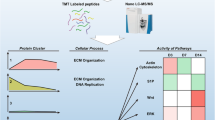Abstract
Fracture healing is a complex process in which the periosteum and endosteum become the main sources of osteoblast progenitor cells. However, cellular mechanisms and signaling cascades underlying the early stages of osteoblast progenitors differentiation in adult bone are still not well understood. Therefore, we performed shotgun proteomics analysis of primary culture of isolated human osteoblasts from femur of adult donors in undifferentiated conditions and on the fifth day of osteogenic differentiation in vitro. This is an early timepoint in which we have observed no extracellular matrix mineralization yet. 1612 proteins identified with at least two unique peptides were included in proteomics analysis. Data are available via ProteomeXchange with identifier PXD033697. Despite the fact, that matrix mineralization starts only after induction of osteogenic differentiation, we revealed unexpectedly weak physiological shift associated with a decrease of cells proliferative activity and changes in proteins involved in extracellular matrix secretion and organization. We demonstrated that osteoblasts were positive for markers of later osteogenic differentiation stages during standard cultivation: osteopontin, osteocalcin, BMP-2/4 and RUNX2. Therefore, further differentiation required for matrix mineralization needs minimal physiological changes.


Similar content being viewed by others
REFERENCES
Bahney, C., Zondervan, R., Allison, P., Theologis, A., Ashley, J., Ahn, J., Miclau, T., Marcucio, R., and Hankenson, K., Cellular biology of fracture healing, J. Orthop. Res., 2019, vol. 37, pp. 35–50. https://doi.org/10.1002/jor.24170
Blighe, K., Sharmila, R., and Myles, L., EnhancedVolcano: publication-ready volcano plots with enhanced colouring and labeling, 2022. https://bioconductor.org/packages/devel/bioc/vignettes/EnhancedVolcano/inst/doc/EnhancedVolcano.html
Bragdon, B. and Bahney, C., Origin of reparative stem cells in fracture healing, Curr. Osteoporos. Rep., 2018, vol. 16, pp. 490–503. https://doi.org/10.1007/s11914-018-0458-4
Cleland, T. and Vashishth, D., Bone protein extraction without demineralization utilizing principles from hydroxyapatite chromatography, Anal. Biochem., 2015, vol. 472, pp. 62–66. https://doi.org/10.1016/j.ab.2014.12.006
Cleland, T., Voegele, K., and Schweitzer, M., Empirical evaluation of bone extraction protocols, PLoS One, 2012, vol. 7, p. e31443. https://doi.org/10.1371/journal.pone.0031443
Florencio-Silva, R., Sasso, G., Sasso-Cerri, E., Simões, M., and Cerri, P., Biology of bone tissue: structure, function, and factors that influence bone cells, Biomed. Res. Int., 2015, vol. 2015, p. e421746. https://doi.org/10.1155/2015/421746
Hastie, T., Tibshirani, R., Narasimhan, B., and Chu, G., Impute: imputation for microarray data. Bioconductor version: release (3.14), 2022. https://www.bioconductor.org/packages/release/bioc/html/impute.html
Jiang, X., Ye, M., Jiang, X., Liu, G., Feng, S., Cui, L., and Zou, H., Method development of efficient protein extraction in bone tissue for proteome analysis, J. Proteome Res., 2007, vol. 6, pp. 2287–2294. https://doi.org/10.1021/pr070056t
Lobov, A. and Malashicheva, A., Osteogenic differentiation: a universal cell program of heterogeneous mesenchymal cells or a similar extracellular matrix mineralizing phenotype?, Biol. Commun., 2022, vol. 67, pp. 32–48. https://doi.org/10.21638/spbu03.2022.104
Matthews, B., Novak, S., Sbrana, F., Funnell, J., Cao, Y., Buckels, E., Grcevic, D., and Kalajzic, I., Heterogeneity of murine periosteum progenitors involved in fracture healing, Elife, 2021, vol. 10, p. e58534. https://doi.org/10.7554/eLife.58534
Perez-Riverol, Y., Bai, J., Bandla, C., García-Seisde-dos, D., Hewapathirana, S., Kamatchinathan, S., Kun-du, D.J., Prakash, A., Frericks-Zipper, A., Eisenacher, M., et al., The PRIDE database resources in 2022: a hub for mass spectrometry-based proteomics evidences, Nucleic Acids Res., 2022, vol. 50, pp. D543–D552. https://doi.org/10.1093/nar/gkab1038
Pitkänen, S., In vitro and in vivo osteogenesis and vasculogenesis in synthetic bone grafts, Doctoral Dissertation, Tampere University, 2020.
Raouf, A., Ganss, B., McMahon, C., Vary, C., Roughley, P.J., and Seth, A. Lumican is a major proteoglycan component of the bone matrix, Matrix Biol., 2002, vol. 21, p. 361–367. https://doi.org/10.1016/s0945-053x(02)00027-6
Ritchie, M.E., Phipson, B., Wu, D., Hu, Y., Law, C.W., Shi, W., Smyth, G.K., Limma powers differential expression analyses for RNA-sequencing and microarray studies, Nucleic Acids Res., 2015, vol. 43, p. e47. https://doi.org/10.1093/nar/gkv007
Rohart, F., Gautier, B., Singh, A., and Cao, K., mixOmics: an R package for ‘omics feature selection and multiple data integration, PLoS Comput. Biol., 2017, vol. 13, p. e1005752. https://doi.org/10.1371/journal.pcbi.1005752
Rutkovskiy, A., Stensløkken, K., and Vaage, I., Osteoblast differentiation at a glance, Med. Sci. Monit. Basic Res., 2016, vol. 22, pp. 95–106. https://doi.org/10.12659/MSMBR.901142
Wickham, H., ggplot2, Cham: Springer Int. Publ., 2016.
Yan L., ggvenn: Draw Venn Diagram by “ggplot2”, 2021. https://cran.r-project.org/web/packages/ggvenn/
ACKNOWLEDGMENTS
Shotgun proteomics were performed in the research center «Molecular and cell technologies» of St. Petersburg State University Research Park.
Funding
The work was supported by the Russian Science Foundation (RSF), research grant no. 18-14-00152.
Author information
Authors and Affiliations
Contributions
Conceptualization, A.A.L.; methodology, I.A.K., A.A.L., A.B.M.; software, I.A.K., A.A.L.; validation, A.A.L., D.S.K., A.B.M.; formal analysis: I.A.K.; investigation, I.A.K., D.S.K., B.R.Z., E.S.G., R.M.T., S.A.B., A.P.S., V.V.K.; resources, A.A.L., A.B.M.; data curation, I.A.K., D.S.K.; writing—original draft preparation, I.A.K.; review and editing, A.A.L. and A.B.M.; visualization, E.S.G., I.A.K.; supervision, A.A.L., A.B.M.; project administration, A.B.M.; funding acquisition, A.A.L., A.B.M. All authors have read and agreed to the published version of the manuscript.
Corresponding author
Ethics declarations
Conflict of interest. The authors declare no conflicts of interest.
Statement of compliance with standards of research involving humans as subjects. All procedures performed in the study involving human beings complied with the ethical standards of the institutional and/or national research ethics committee and the 1964 Helsinki Declaration and its subsequent changes or comparable ethical standards. An informed written consent was obtained from each of the participants enrolled in the study.
Additional information
Abbreviations: DAVID—database for Aanotation, visualization and integrated discovery, DMEM—Dulbecco’s modified Eagle medium; ECM—extracellular matrix, FBS—fetal bovine serum, FDR—false discovery rate; GO BP—gene ontology biological process, MSC—mesenchymal stem cells, PBS—phosphate-buffered saline, PCA—principal component analysis, sPLS-DA—sparse partial least squares discriminant analysis, VEGF— vascular endothelial growth factors.
Supplementary Information
Rights and permissions
About this article
Cite this article
Khvorova, I.A., Kostina, D.A., Zainullina, B.R. et al. Osteogenic Differentiation In Vitro of Human Osteoblasts Is Associated with Only Slight Shift in Their Proteomics Profile. Cell Tiss. Biol. 16, 540–546 (2022). https://doi.org/10.1134/S1990519X22060025
Received:
Revised:
Accepted:
Published:
Issue Date:
DOI: https://doi.org/10.1134/S1990519X22060025




